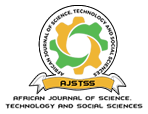Health-related quality of life: differences between human-wildlife interface and non- wildlife zones of Meru county, Kenya
DOI:
https://doi.org/10.58506/ajstss.v1i1.81Keywords:
HRQoL, wildlife zones, non-wildlife zones, Meru CountyAbstract
Background: EuroQol-five dimension-five level (EQ-5D-5L) instrument is one of the most applied patient reported outcomes questionnaire globally. However, its novel application to surveil, compare and report the Health Related Quality of Life (HRQoL) of different populations is rare.This study aimed to estimate and compare the HRQoL of residents at the interface of Meru National Park in Igembe Central and the non-wildlife zone of Tigania West Sub-Counties of Meru County, Kenya. Methods: Sample frames were constructed from Meru County Ministry of Health registers and respondents systematically sampled. Data were gathered through EQ-5D-5L and structured demographic questionnaires and analyzed. Associations between HRQoL variables and hypothesis were tested through chi statistic and odds ratios respectively. Results: The HRQoL dimension of worry statistically differed significantly by nearness to the National Park between the two populations at 95% CI. χ² (1, N=525) =35.5281, p< .001. Populations at the brink of Meru National Park were 3 times more likely to report problems in the worry dimension of the EQ-5D-5L than their counterparts in the non-wildlife zones of Tigania West (OR3.068, 95% CI: 2.109 to 4.463) p< .00001). Further studies are required to establish the cause of anxiety/depression in this area to improve population mental health.


